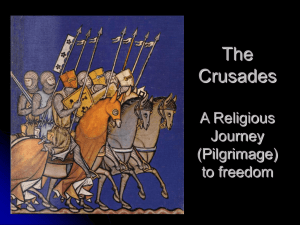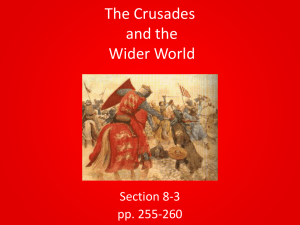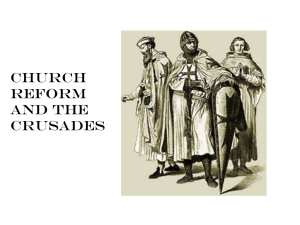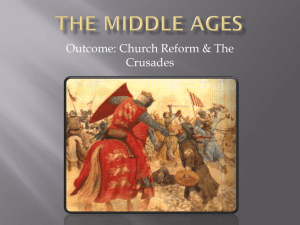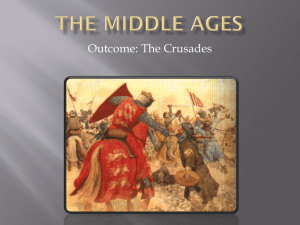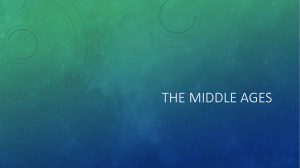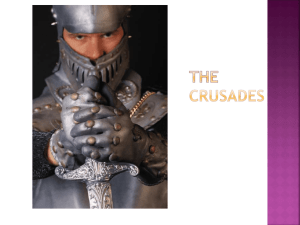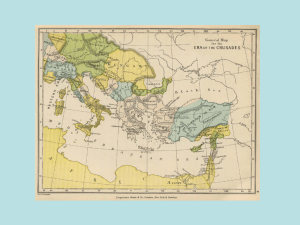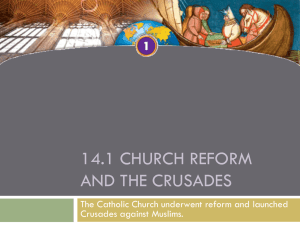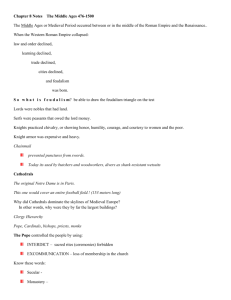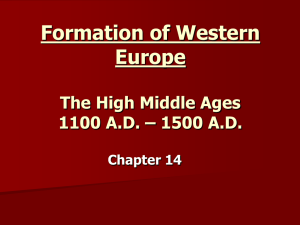Crusades - Summary and King Richard powerpoint
advertisement
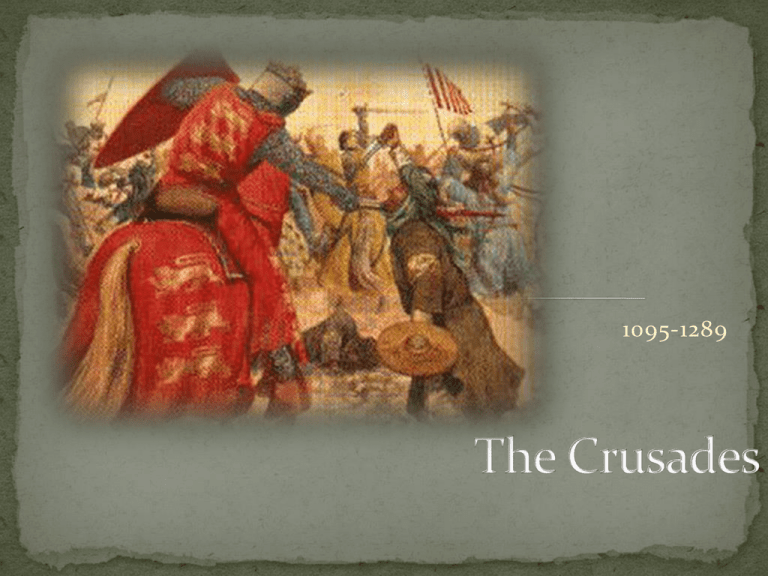
1095-1289 Medieval Europe was very much a Christian society, however the area where Jesus Christ had lived and died belonged the Muslims….. What’s the difference between Muslims and Christians?? Topic Christianity Islam Origin of the Name From the Greek:christos, 'Anointed' referring to Jesus Christ. Derived from an Arabic word for 'submission'. Also related to the Arabic word salaam, 'peace'. Founder Jesus Christ (c. 4 B.C. - 30 A.D.) Mohammed (570 - 632 A.D.) Divisions Three main groups: Orthodox, Protestant and Roman Catholic. Two main groups: Sunni and Shia (The division occured due to a dispute as to the legitimate successor of the prophet Mohammed). There is also a mystical/ascetic movement in Islam known as Sufi. Nature of God One God, who exists in three distinct persons (The Trinity): Father, Son and Holy Spirit (Matthew 28:19). One God (Arabic: Allah), who is not a trinity. The Islamic view of God is called strict Monotheism (Quran 112:1). Holy Book(s) The Bible (from the Greek:Biblos, 'books'), given by God to man. The Bible writers were inspired by God in their writings. Thus Christians refer to the Bible as the Word of God (2 Timothy 3:16). The Quran or Koran (Arabic: 'recitation'), revealed to the prophet Mohammed over a period of about 20 years. The Quran is the final revelation given by Allah to mankind. Jesus Christ The second person of the Trinity and born of A prophet, sent by Allah and born of the Virgin the Virgin Mary. "...true God from true God" Mary, but not divine (Quran 5:17). (Nicene Creed) Jesus Christ, The Mission of Jesus Christ, The Death of To proclaim the Injil, or gospel. This gospel has To reconcile Man to God, through his death been corrupted over time by human additions and as a sacrifice for the sins of all mankind. alterations. "...For our sake he was crucified...he suffered death and was buried. On the third Jesus was not crucified (Quran 4:157), but was day he rose again...he ascended into raised to Heaven by Allah (4:158). heaven..." (Nicene Creed) Up until the 11th century the Muslims allowed pilgrims to travel to Jerusalem to see where Jesus Christ had preached and been crucified In 1095 this area was taken over by Turkish Muslims who refused to let Christian pilgrims visit Jerusalem anymore. The Turks murdered any pilgrims who defied them. In 1905 these murders led Pope Urban II to urge the people of Christendom to embark upon a crusade or ‘war of the cross’ Most beloved brethren: Urged by necessity, I, Urban, by the permission of God chief bishop and prelate over the whole world, have come ……. with a divine admonition to you, the servants of God……. your brethren who live in the east are in urgent need of your help, . For, the Turks and Arabs have attacked them…... They have killed and captured many, and have destroyed the churches and devastated the empire. ….I, or rather the Lord, beseech you as Christ's heralds……. to persuade all people of whatever rank, foot-soldiers and knights, poor and rich, to carry aid promptly to those Christians and to destroy that vile race from the lands of our friends. I say this to those who are present, it meant also for those who are absent. Moreover, Christ commands it. "All who die by the way, whether by land or by sea, or in battle against the pagans, shall have immediate remission of sins…….. O what a disgrace if such a despised and base race, which worships demons, should conquer a people which has the faith of omnipotent God and is made glorious with the name of Christ! …… Let those who have been accustomed unjustly to wage private warfare against the faithful now go against the infidels…... Let those who …have been robbers, now become knights. Let those who have been fighting against their brothers and relatives now fight in a proper way against the barbarians. Let those who have been serving as mercenaries for small pay now obtain the eternal reward. Let those who have been wearing themselves out in both body and soul now work for a double honor. Behold! on this side will be the sorrowful and poor, on that, the rich; on this side, the enemies of the Lord, on that, his friends. Let those who …..eagerly set out on the way with God as their guide." The first crusade was successful in recapturing Jerusalem and setting up a Christian holy land These new Christian kingdoms proved difficult to defend against the Muslims. Over the next 200 years there were several more Crusades. Not all of them were successful. By 1291, when Acre, the last Christian city in the Holy land, was recaptured by the Muslims, the medieval people were forced to accept the fact the Holy land would remain a Muslim country I. Why did the medieval Christians wish to travel to the Holy land ? II. What happened at the end of the eleventh century to prevent them from travelling there? III. How did Pope Urban II view the Muslims and the Arabs. Use evidence to support your answer. IV. What did he offer Christians to persuade them to go on Crusades? The third crusade was led by the kings of France and England and the German emperor. The aim was to take back Jerusalem and the Holy Land from the ‘infidels’ led by Saladin* The hero of these three Christian monarch was the charismatic King of England, Richard I , who was called ‘the Lionheart” because of his courage and bravery. Richard I was born in 1157 and was the third son of Henry II of England and Eleanor of Acquitane His older brothers both died before they could ascend to the throne, so when Henry II died the crown passed to Richard. He was a popular king because of his knightly qualities- hence his nickname-but the truth is that over his ten year reign , from 1189-1199 he only spent six months in England and complained that it was ‘cold and always raining’ and he could not even spend English. When the news reached Europe that Jerusalem and Acre had fallen, Richard was quick to take up the challenge of a crusade. Historians speculate that he had three main reasons for taking up the cross- to take part in the adventure of war, to have his name immortalised by the bards and troubadours of the time, and to ensure his place in heaven. The German emperor, Frederick, was drowned on his way across Europe to join the Crusade and Phillip II of France went home after quarrelling with Richard. Richard was left to lead the Crusades on his own. His clever battle tactics and strategies enabled him to successfully end the siege of Acre, but without his allies he was unable to continue to Jerusalem. He was forced to return home, despite only being a few miles from the holy city. He vowed never to set eyes on Jerusalem as he believed that God had ordained that he should not be the one to conquer it. One of the most unusual military manoeuvres ever was performed in 1191, during the third Crusade, when Richard the Lion-Hearted captured the city of Acre. The inhabitants were barricaded inside, so King Richard had his soldiers throw 100 beehives over the walls. The people in the fortress surrendered immediately. 1. What to the colour and symbols mean on each shield? (refer to shields handout) These two shields were similar in style to those used by Richard before and after the crusades. 2. Which shield do you think Richard used after his crusade? Explain your choice. Weakening of the Feudal System New Ideas Islamic contributions to Medieval Europe By the time of the last crusade at the end of the thirteenth century, the medieval feudal system that had worked so well for William the Conqueror and other European rulers was no longer as strong a force because…. Kings became stronger, as many knights and noblemen were killed while on crusades, and so countries as they were began to change. Serfs who had been on crusades gained a new freedom on their return New independent towns came into existence, as lords had often encouraged towns to buy their freedom in order to raise money for the crusades. These new towns became more involved in trade, so the use of money rather than barter increased, and a new merchant class was formed that had no place in the old feudal system. The Crusades brought back many new goods and ideas that changed the way people lived……. Luxury goods such as silks, spices and carpets-wealthy nobles and merchants now desired these goods in their homes, which increased trade and led to the growth of towns Gunpowder, which meant that castles became ineffective as means of defence. Opium was brought back as a pain killer Washing and cleanliness was more widely practised by Muslims . Rice, coffee, sugar, raisins, dates and apricots which added variety to the diet. Arabic numbers were introduced. What’s wrong with this picture ? The Normans (1066 - 1154) King William I, the Conqueror 1066 1087 Significant events Doomsday book compiled King Henry I 1100 - 1135 King Stephen 1135 - 1154 First crusade Empress Matilda 1141 Second Crusade Plantagenets (1154 - 1399) Knights Templar founded King Henry II 1154 - 1189 Thomas a Beckett is murdered in Canterbury Cathedral Fourth Crusade Childrens Crusade Magna Carta signed. See the rubric for details on what your presentation requires. Peasants revolt You will have class time to complete and homework to research and plan. King Richard I the Lionheart 1189 - 1199 Third Crusade King John 1 1199 - 1216 Choose one of the events or rulers of England during the Medieval period and present a short PowerPoint on your research. King Henry III 1216 - 1272 King Edward I 1272 - 1307 King Edward II 1307 - 1327 King Edward III 1327 - 1377 Richard II 1377 - 1399 The House of Lancaster (1399 - 1461) Henry IV 1399 - 1413 Henry V 1413 - 1422 Battle of Agincourt Henry VI 1422 - 1461, 1470 - 1471 Joan of Arc.
